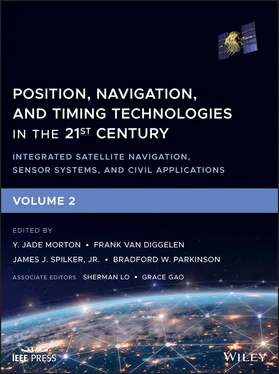1 Cover
2 Title Page
3 Copyright Page Copyright © 2021 by The Institute of Electrical and Electronics Engineers, Inc. All rights reserved. Published by John Wiley & Sons, Inc., Hoboken, New Jersey. Published simultaneously in Canada. No part of this publication may be reproduced, stored in a retrieval system, or transmitted in any form or by any means, electronic, mechanical, photocopying, recording, scanning, or otherwise, except as permitted under Section 107 or 108 of the 1976 United States Copyright Act, without either the prior written permission of the Publisher, or authorization through payment of the appropriate per‐copy fee to the Copyright Clearance Center, Inc., 222 Rosewood Drive, Danvers, MA 01923, (978) 750‐8400, fax (978) 750‐4470, or on the web at www.copyright.com . Requests to the Publisher for permission should be addressed to the Permissions Department, John Wiley & Sons, Inc., 111 River Street, Hoboken, NJ 07030, (201) 748‐6011, fax (201) 748‐6008, or online at http://www.wiley.com/go/permissions . Limit of Liability/Disclaimer of Warranty: While the publisher and author have used their best efforts in preparing this book, they make no representations or warranties with respect to the accuracy or completeness of the contents of this book and specifically disclaim any implied warranties of merchantability or fitness for a particular purpose. No warranty may be created or extended by sales representatives or written sales materials. The advice and strategies contained herein may not be suitable for your situation. You should consult with a professional where appropriate. Neither the publisher nor author shall be liable for any loss of profit or any other commercial damages, including but not limited to special, incidental, consequential, or other damages. For general information on our other products and services or for technical support, please contact our Customer Care Department within the United States at (800) 762‐2974, outside the United States at (317) 572‐3993 or fax (317) 572‐4002. Wiley also publishes its books in a variety of electronic formats. Some content that appears in print may not be available in electronic formats. For more information about Wiley products, visit our web site at www.wiley.com . Library of Congress Cataloging‐in‐Publication Data is available. ISBN: 9781119458340 Cloth Cover Design: Wiley Cover Images: Global telecommunication network © NicoElNino/Getty Images, GPS Satellite © BlackJack3D/iStockphoto
4 Dedication Page In Memory of:Ronald L. BeardPer EngeRonald HatchDavid LastJames J. Spilker, Jr.James B. Y. Tsui
5 Preface
6 Contributors
7 Part D: Position, Navigation, and Timing Using Radio Signals-of-Opportunity 35 Overview of Volume 2: Integrated PNT Technologies and Applications 35.1 Generalized Navigation Framework 35.2 Summary of Content of Volume 2 36 Nonlinear Recursive Estimation for Integrated Navigation Systems 36.1 Introduction 36.2 Linear Estimation Foundations 36.3 Nonlinear Filtering Concepts 36.4 Summary and Conclusions References 37 Overview of Indoor Navigation Techniques 37.1 Introduction 37.2 Overview of Technical Terms 37.3 Performance Metrics 37.4 Indoor Localization Signal Classification 37.5 Indoor Localization Techniques 37.6 Open Research Issues References 38 Navigation with Cellular Signals of Opportunity 38.1 Introduction 38.2 Overview of Cellular Systems 38.3 Clock Error Dynamics Modeling 38.4 Navigation Frameworks in Cellular Environments 38.5 Navigation with Cellular CDMA Signals 38.6 Navigation with Cellular LTE Signals 38.7 BTS Sector Clock Bias Mismatch 38.8 Multi‐Signal Navigation: GNSS and Cellular 38.9 Cellular‐Aided INS References 39 Position, Navigation and Timing with Dedicated Metropolitan Beacon Systems 39.1 Metropolitan Beacon System (MBS) References 40 Navigation with Terrestrial Digital Broadcasting Signals 40.1 PNT Mechanisms with Broadcasting Signals 40.2 Representative Terrestrial Digital Broadcasting Signals 40.3 Pseudorange Measurements from Broadcasting Signals 40.4 Practical Issues and Search for Solutions References 41 Navigation with Low‐Frequency Radio Signals 41.1 Introduction 41.2 A Brief History of Very Low‐Frequency (VLF) and LF PNT 41.3 Loran‐C and eLoran Signal in Space Definition 41.4 Enhanced Loran (eLoran) Transmission 41.5 LF Propagation 41.6 Noise and Interference 41.7 Receiver Design 41.8 Loran Performance: Past, Present, and Future 41.9 Potential of Future LF Radio Navigation Systems References 42 Adaptive Radar Navigation 42.1 A History of Radar Localization 42.2 Modern Radar Localization 42.3 Radar Signal Processing 42.4 SAR Processing Methods 42.5 UWB‐OFDM Case Study 42.6 Conclusion References 43 Navigation from Low Earth Orbit 43.1 Introduction 43.2 Background 43.3 LEOs in Navigation Today 43.4 LEOs in Navigation Tomorrow 43.5 Conclusion References 43 Navigation from Low‐Earth Orbit 43.6 Introduction 43.7 LEO Satellite Pseudorange, Carrier Phase, and Doppler Measurement Model 43.8 LEO Satellite Orbital Dynamics Model 43.9 Navigation Error Sources 43.10 Overview of Orbcomm LEO Satellite Constellation 43.11 Overview of Starlink LEO Satellite Constellation 43.12 Carrier‐Phase Differential Navigation with LEO Satellite Signals 43.13 STAN: Simultaneous Tracking and Navigation with LEO Satellites’ Signals 43.14 Dilution of Precision Analysis 43.15 Simulation Results 43.16 Experimental Results References
8 Part E: Position, Navigation, and Timing Using Non-Radio signals of Opportunity 44 Inertial Navigation Sensors 44.1 Introduction 44.2 Inertial Navigation Performance 44.3 IMU Performance Classes 44.4 Accelerometer Taxonomy 44.5 Gyroscopes 44.6 Conclusion References 45 MEMS Inertial Sensors 45.1 Introduction to Micro‐Electromechanical Systems (MEMS) Inertial Sensors 45.2 MEMS Accelerometers 45.3 MEMS Gyroscopes 45.4 MEMS IMUs 45.5 Using MEMS Inertial Sensors in Navigation Solutions References 46 GNSS‐INS Integration 46.1 Main Principles of Inertial Navigation 46.2 Inertial Error Propagation 46.3 Loose Integration: Solution‐Domain Sensor Fusion 46.4 Tight Integration: Measurement‐Domain Sensor Fusion 46.5 Deep Integration: Sensor Fusion at the Signal Processing Level 46.6 Implementation Case Studies References 46 GNSS‐INS Integration A. Appendix References 47 Atomic Clocks for GNSS 47.1 Introduction 47.2 Basic Concepts 47.3 GNSS Space Clocks 47.4 Advanced Atomic Clocks for Future Use in Space 47.5 Einstein’s Relativity for Clocks near Earth – Brief Summary 47.6 Atomic Clocks on Earth Supporting GNSS 47.7 National Standards Laboratories 47.8 AFRs for GNSS Receivers 47.9 Chip Scale Atomic Clocks (CSACs) Acknowledgments References 48 Positioning Using Magnetic Fields 48.1 Introduction 48.2 Magnetic Field Sources 48.3 Magnetic Measurements and Instruments 48.4 Magnetometer Calibration Approaches 48.5 Absolute Positioning Using Magnetic Fields Disclaimer References 49 Laser‐Based Navigation 49.1 Introduction 49.2 Laser‐Based Sensor Technology and Their Observables 49.3 Laser‐Based Navigation Approaches 49.4 General Considerations References 50 Image‐Aided Navigation – Concepts and Applications 50.1 Introduction 50.2 Imaging System Model 50.3 Selection of Interest Areas 50.4 Correspondence Search 50.5 Pose Estimation 50.6 Monocular Image Navigation Issues 50.7 Application of Additional Information to the Image‐Aided Navigation Solution 50.8 Non‐Homogeneous Sensor Fusion 50.9 Conclusion References 51 Digital Photogrammetry 51.1 Introduction 51.2 Optical Imagery 51.3 Basic Definitions 51.4 Fundamentals of Photogrammetry 51.5 Photogrammetric Processing Workflow 51.6 Applications 51.7 Conclusion References 52 Navigation Using Pulsars and Other Variable Celestial Sources 52.1 Navigation Concepts and Benefits 52.2 Variable Celestial Sources 52.3 Applications for Spacecraft and Planetary Vehicles 52.4 Current Technology Limitations and Future Developments Acknowledgments References 53 Neuroscience of Navigation 53.1 Introduction 53.2 Spatial Foundations 53.3 Specialized Spatial Cells 53.4 Neural Systems and Navigation 53.5 Future Directions 53.6 Conclusion References 54 Orientation and Navigation in the Animal World 54.1 What Information Do Animals Use to Orientate and Navigate? 54.2 Star Compass 54.3 Radical‐Pair‐Based Magnetoreceptor 54.4 Conclusions and Perspectives References
Читать дальше











